From Phoenix to Flagstaff, the Grand Canyon State is home to some amazing birds. With 558 species observed on ebird, Arizona’s warm weather and vast geography provide for a diverse habitat. In this post we’ll review 30 of the most common and colorful birds in Arizona along with some helpful data on when and where to find them.
We even sampled 5 years of aggregate data from ebird’s Arizona checklists to compile easy-to-use statistics and graphs to help identify each bird species. So whether you’re just watching the backyard bird feeder or venturing to birding hotspots like Patagonia Lake State Park or Sweetwater Wetlands – we’ll have you ready to start bird watching like a professional.
Abert’s Towhee
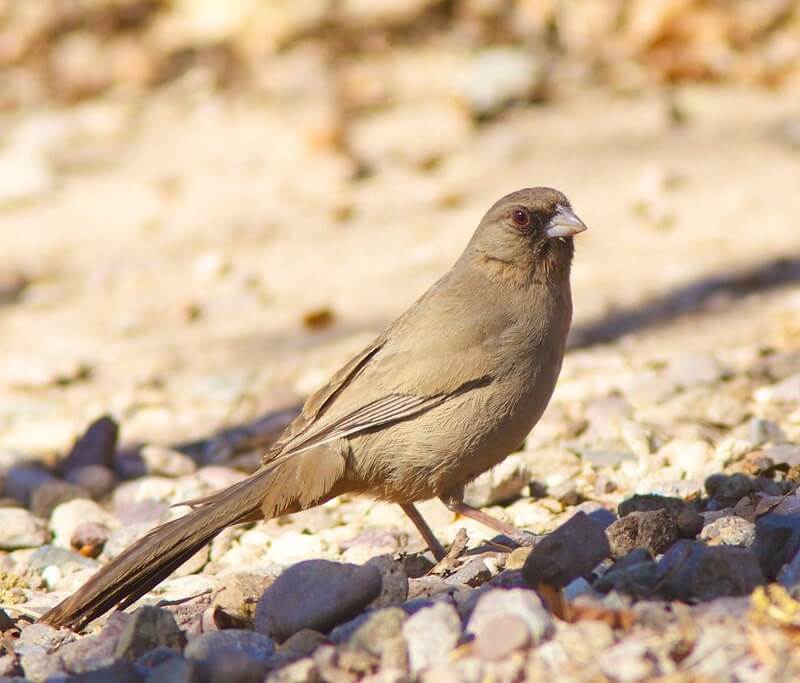
The Abert’s Towhee can be seen year-round in Arizona.
- Pipilo aberti
- Size: 9″ (23cm)
- AZ Checklist Frequency High: 28% in December
- AZ Checklist Frequency Low: 16% in August
Identification and Color: The Abert’s Towhee has a thick bill and long tail. Brown all over except for a black patch at the bill and reddish belly area. Adults average between 8 to 9 inches in length.
Habitat and Behavior: Can be found in the southwest and generally stays in that area. Prefers a water source such as a nearby stream or marsh and staying in the brush along them. Typically they stay close to the ground or in lower bushes.
Diet: Insects make up the majority of an Abert’s Towhee diet including beetles, ants, and caterpillars. They will also eat some grass and weed seeds.
American Kestrel

The American Kestrel is a year-round resident of Arizona.
- Falco sparverius
- Size: 9″ (23cm)
- AZ Checklist Frequency High: 17% in December
- AZ Checklist Frequency Low: 4% in May
Identification and Color: Known as the smallest falcon. They have intricate patterns and multiple colors. Their bodies are covered with black spots. The male’s body has a top color of rusty red, then a grey or blue strip, then white. A female is red and white without the blue-grey stripe. Both sexes have black slash marks on their heads.
Habitat and Behavior: Found throughout the United States and some parts of Canada. Their habitat can vary but they prefer open spaces and perching high up above the ground. Will often spot prey from their high perch and swoop down on it.
Diet: The American Kestrel will feed on large insects such as grasshoppers or beetles. They will also catch small mammals or reptiles.
Anna’s Hummingbird
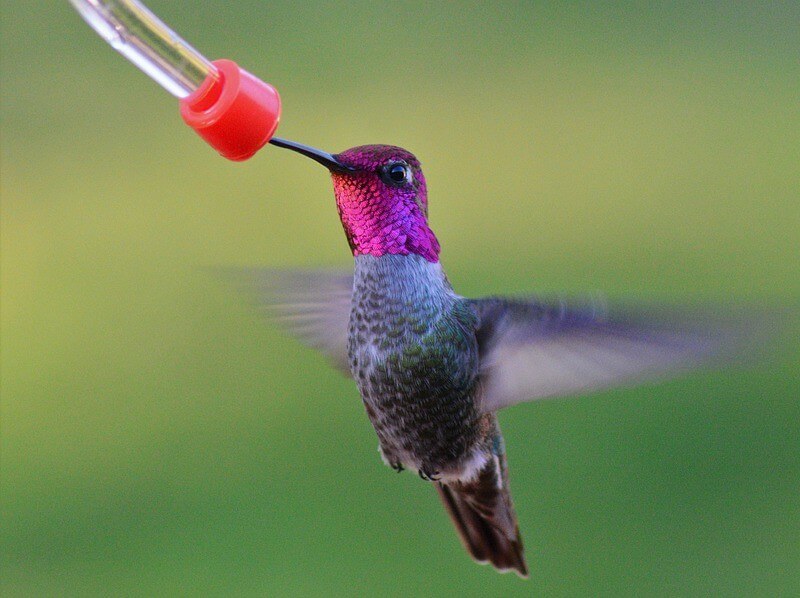
Anna’s Hummingbird is seen year-round in Arizona.
- Calypte anna
- Size: 4″ (10 cm)
- AZ Checklist Frequency High: 35% in October
- AZ Checklist Frequency Low: 19% in August
Identification and Color: Growing to only 4 inches in length, Anna’s Hummingbird is on the stocky side. They have a short, straight bill and long tail. Mostly green and grey, but males have iridescent pink around their heads. Both sexes have white on their undersides.
Habitat and Behavior: Found on the west coast year-round. Will visit feeders in gardens or parks. Can be located in open woods or by streams and rivers. They are very fast and can be hard to see while in motion. Will stop and hover over a flower or feeder to eat.
Diet: Anna’s Hummingbird diet consists of nectar and tiny insects.
Belted Kingfisher

The Belted Kingfisher is a year-round resident of Arizona waterways, less common in the summer months.
- Megaceryle alcyon
- Size: 13″ (33 cm)
- AZ Checklist Frequency High: 8% in October
- AZ Checklist Frequency Low: 1% in Summer
Identification and Color: These birds have bushy crests on their heads. Both males and females have blue-grey on their heads and their bodies are broken up with some white underparts. They also have a stripe in between their head and body. Females have a reddish brown part on their undersides. They have a thick pointed bill, short legs, and a large head.
Habitat and Behavior: Belted Kingfishers are common all over North America. Many will stay put in the United States for all seasons, and some fly very far south for winter. Will stay close to water such as streams or lakes. Spends most of the time alone overlooking the water for food.
Diet: The Belted Kingfisher mainly eats small fish but will also eat crayfish or frogs. May also eat some berries but only on rare occasions.
Black Phoebe
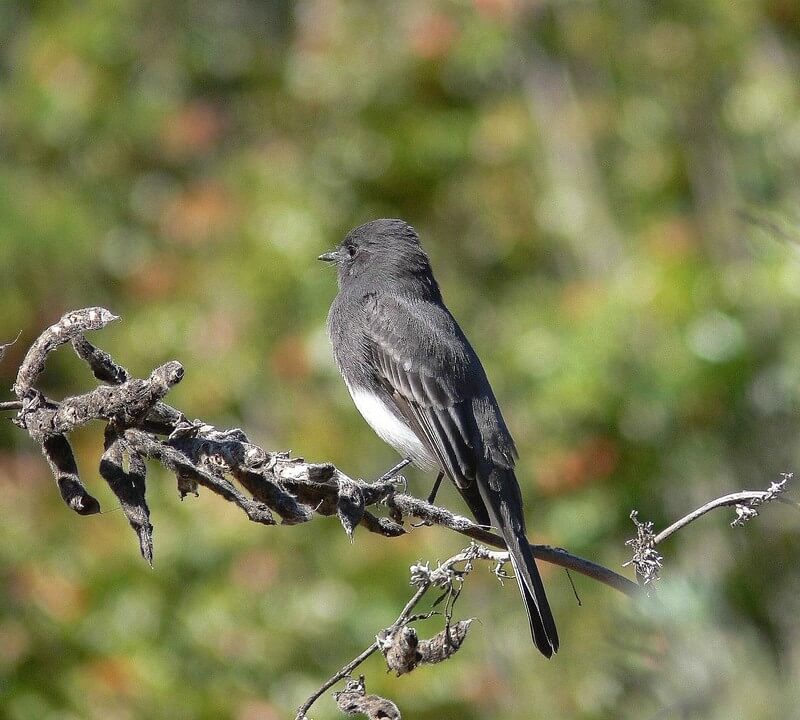
The Black Phoebe can be seen year-round in Arizona.
- Sayornis nigricans
- Size: 7″ (17 cm)
- AZ Checklist Frequency High: 24% in December
- AZ Checklist Frequency Low: 9% in May
Identification and Color: The Black Phoebe has a dark black at the top of the head, going into a dark and light gray, to a stark white belly patch. They have large heads and squared tails. Their bills are straight, pointed, and small. Full-grown adults are still very small.
Habitat and Behavior: Found through the west coast, south, and into Mexico. Preferring to be by water, the west coast residents are usually by the Pacific Ocean and other locations will be by a stream or other water source. They will perch waiting to make a short flight when an insect is spotted.
Diet: The Black Phoebe mainly eats insects, but will sometimes go after small fish.
Brown-headed Cowbird

The Brown-headed Cowbird is commonly seen in Arizona during the hotter months.
- Molothrus ater
- Size: 7.5″ (19 cm)
- AZ Checklist Frequency High: 24% in May
- AZ Checklist Frequency Low: 2% in December
Identification and Color: Males have a chocolate brown head and glossy black body. Females are duller in color with a streaked brown head and body.
Habitat and Behavior: Found in open areas like fields and meadows. Will also frequent forest edges. This bird gets its name from its habit of following cattle around and eating the insects they stir up. The Brown-headed Cowbird is a parasitic nester, meaning it will lay its eggs in other birds’ nests and let them raise its young.
Diet: Mainly insects and seeds. Will visit seed feeders.
Common Gallinule

The Common Gallinule can be seen near areas of water in Arizona all year round.
- Gallinula galeata
- Size: 14″ (36 cm)
- AZ Checklist Frequency High: 3% in November
- AZ Checklist Frequency Low: 1% in August
Identification and Color: A black to dark grey head with a red front patch and a bill with a yellow tip. Their bodies are dark gray going to brown. They have white strips going down their sides. Very long legs and a small, thin bill. Adults can be up to 14 inches in length and have a wingspan between 21 and 24 inches.
Habitat and Behavior: Prefers marshland in North and South America. Marshes, ponds, and lakes with mixes of open water and vegetation are all likely spots for the Common Gallinule. Will forage while swimming, walking on land, or through the marsh vegetation.
Diet: The Common Gallinule is omnivorous. Will eat water plant materials, berries and fruits, insects, and sometimes carrion.
Common Yellowthroat

The Common Yellowthroat is a small songbird commonly seen in Arizona year-round.
- Geothlypis trichas
- Size: 5″ (13 cm)
- AZ Checklist Frequency High: 11% in April
- AZ Checklist Frequency Low: 2% in February
Identification and Color: Distinctive yellow throat patch and black mask. Pointy long thinned bill.
Habitat and Behavior: Often found in open woodlands and wetlands. The Common Yellowthroat is a fairly secretive bird, making it difficult to spot. However, the males are often heard singing their distinctive “witchity-witchity-witchity” song.
Diet: The Common Yellowthroat enjoys a variety of insects.
Eurasian Collared-Dove

The Eurasian Collared-Dove is most often seen during the summer months in Arizona.
- Streptopelia decaocto
- Size: 13″ (33 cm)
- AZ Checklist Frequency High: 21% in September
- AZ Checklist Frequency Low: 15% in August
Identification and Color: The Eurasian Collared-Dove has a light grey to brown head and a light brown body. They have a distinct black mark around the back of their neck and some white patches on their tail. They have rounded bodies and small heads. Rounded wings and squared tails. Their bills are slender with a slight curve.
Habitat and Behavior: Found all over the United States with no consistent migration. Can be found in urban areas and open farmland as well. When walking they can be seen bobbing their heads and flicking their tails. Will mainly forage on the ground.
Diet: The Eurasian Collared-Dove enjoys seeds from plants and waste grain. Will also eat some berries or insects.
European Starling

The European Starling is native to Europe but was introduced to North America in the late 1800’s. Considered an invasive species, they are a common backyard bird in Arizona.
- Sturnus vulgaris
- Size: 8.5″ (22 cm)
- AZ Checklist Frequency High: 19% in November
- AZ Checklist Frequency Low: 7% in August
Identification and Color: Small, stocky black birds with glossy feathers and a slender pointed bill. Speckled with white spots.
Habitat and Behavior: European starlings can be found in woods, fields, and other open areas. They often build their nests in trees or holes in buildings. European starlings are also known for their elaborate vocalizations, often imitating the sounds of other birds.
Diet: European starlings are opportunistic eaters and will feed on a variety of insects, fruits and seeds.
Gambel’s Quail
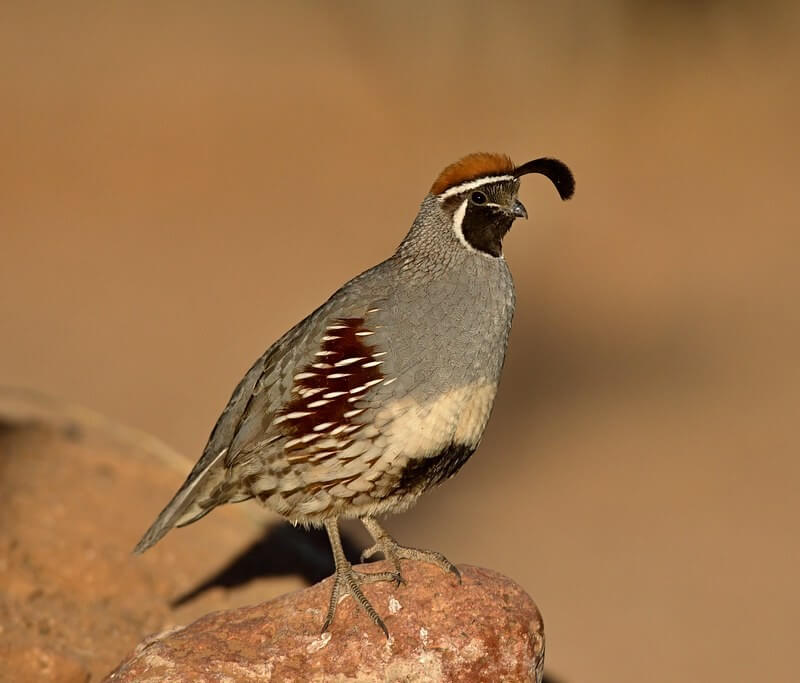
The Gambel’s Quail is seen year-round in Arizona.
- Callipepla gambelii
- Size: 11″ (28 cm)
- AZ Checklist Frequency High: 30% in May
- AZ Checklist Frequency Low: 16% in August
Identification and Color: Males have a distinct red-brown patch on the top of their heads, and black and white face markings with a black belly patch. Females have less distinct head markings and are more grey all over. Both sexes have comma-shaped crests on their heads. They have squared tails and short, broad wings.
Habitat and Behavior: Gambel’s Quail are found in a small area of the southwest and are permanent residents there. Prefers the hot, desert. Can be found in brush, shrubs, and cactus. Forages in large groups by running on the ground. Will also find some food in low shrubs.
Diet: Gambel’s Quail has a diet focused on seeds, leaves, and berries. Very few insects are eaten if any.
Gila Woodpecker
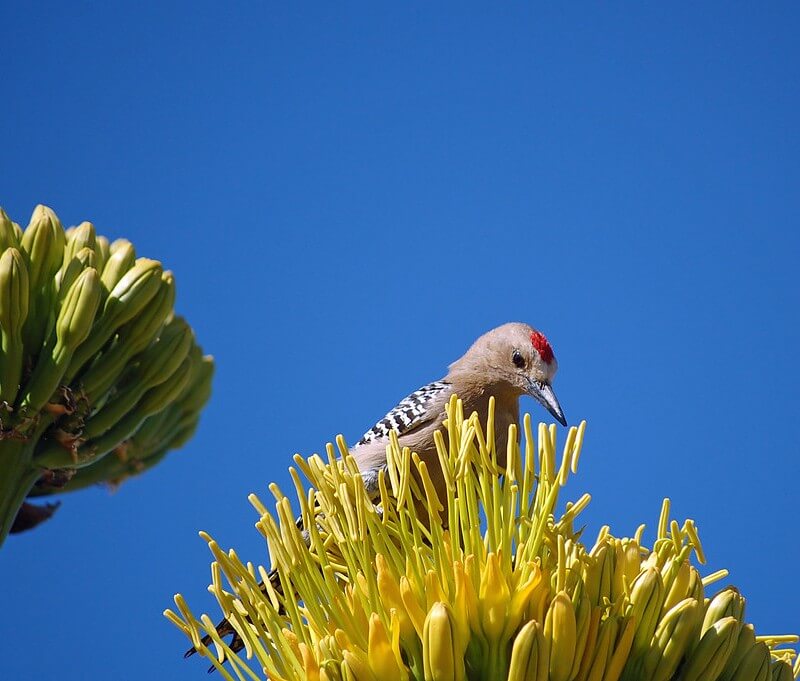
The Gila Woodpecker is a year-round resident of Arizona.
- Melanerpes uropygialis
- Size: 10″ (25 cm)
- AZ Checklist Frequency High: 46% in December
- AZ Checklist Frequency Low: 27% in August
Identification and Color: The Gila Woodpecker has a grey-brown body, with black and white barring throughout their wings. Males have a bright red patch on their heads. A long and pointed bill. Between 8 and 9 inches in length, they are medium-sized woodpeckers.
Habitat and Behavior: Found in a small area of the southwest desert, they like to be around saguaro cactus and desert scrub. Will forage around the cactus and other vegetation and are very protective of their areas. Will occasionally forage on the ground.
Diet: The Gila Woodpecker is omnivorous, with a diet that includes insects, fruit, and seeds. They will eat cactus fruit, small lizards, and may visit a hummingbird feeder for the sugar water.
Great-tailed Grackle
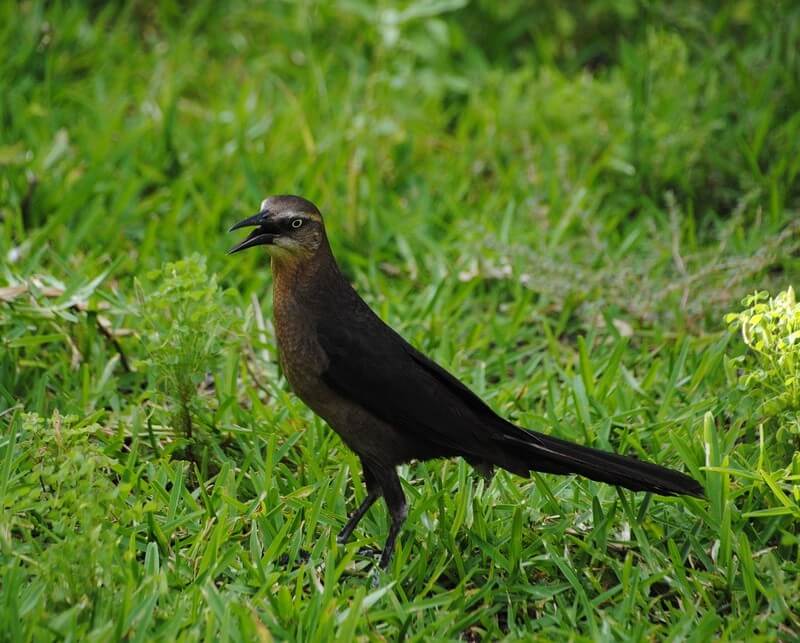
The Great-tailed Grackle is seen year-round in Arizona.
- Quiscalus mexicanus
- Size: 18″ (46 cm)
- AZ Checklist Frequency High: 26% in November
- AZ Checklist Frequency Low: 13% in August
Identification and Color: Males have a shimmering black color with yellow eyes. Females are brown with darker patches on the back of their heads. Both sexes have black, long, straight bills. Males have very large tails that taper out. Females have long but slender tails.
Habitat and Behavior: The Great-tailed Grackle mainly stays in the southwestern states, with the northernmost migrating south. Can be found in rural towns or farms. Can also be found in marshes or irrigated fields. Will forage on the ground or in shallow water.
Diet: Great-tailed Grackles have omnivorous diets. Enjoys a wide variety of insects, seeds, berries, nuts, and small water creatures.
House Finch

The House Finch is a common bird across North America, seen year-round in Arizona.
- Carpodacus mexicanus
- Size: 5″ (13 cm)
- AZ Checklist Frequency High: 53% in March
- AZ Checklist Frequency Low: 38% in August
Identification and Color: Fairly small, measuring only about 5-6 inches long. House Finches are relatively easy to identify thanks to their characteristic red plumage near the eyes and throat. Males are typically redder than females, but both genders have distinctive streaks on their breast and belly.
Habitat and Behavior: House Finches are found in a variety of habitats, including woods, gardens, and open fields. A rather social bird that often travels in flocks. Can often be seen perching on power lines or fences in suburban areas.
Diet: House Finches are primarily seed eaters, but they will also consume insects and fruit on occasion.
House Sparrow

One of the most common backyard birds in Arizona. The House Sparrow is seen year-round.
- Passer domesticus
- Size: 6″ (15 cm)
- AZ Checklist Frequency High: 25% in June
- AZ Checklist Frequency Low: 13% in August
Identification and Color: A small plump bird with brown feathers and a grayish-plain breast. They have a black stripe on their face that extends from their bill to their throat. Wings are streaked with black and white.
Habitat and Behavior: Found in open areas with some trees nearby, such as farmland, parks, and suburban neighborhoods. They build their nests in holes in tree trunks or in man-made structures such as gutters, light fixtures, and nest boxes. House Sparrows are social birds that often form large flocks. You won’t be surprised to see them downtown near restaurants with outdoor seating!
Diet: House Sparrows eat mostly seeds and grains, but will also eat insects, berries, and other fruits. Happy to pick up crumbs and leftover human food where available.
Killdeer

The Killdeer is seen in Arizona year-round.
- Charadrius vociferous
- Size: 10″ (25 cm)
- AZ Checklist Frequency High: 18% in September
- AZ Checklist Frequency Low: 9% in August
Identification and Color: Mostly brown on the head and top of the body. The head is marked with black and white patches. A white underpart with two black stripes across it. An orange tail part can be seen when in flight. The Killdeer has a long tail and long wings. A small and short bill.
Habitat and Behavior: Located throughout North America. Southern birds are mostly permanent residents and northern birds will migrate. Killdeer like to be in very open areas of lawns, fields, and coastline. Spends the majority of time on the ground running around.
Diet: Insects make up the bulk of their diet. Beetles, grasshoppers, and caterpillars are frequent favorites. They may also eat a small number of seeds.
Lesser Goldfinch

The Lesser Goldfinch is a year-round resident of Arizona.
- Spinus psaltria
- Size: 5″ (13 cm)
- AZ Checklist Frequency High: 45% in August
- AZ Checklist Frequency Low: 23% in December
Identification and Color: Males have black on top of their heads and bodies. They have a bright yellow underpart and white bars on their wings. Females have a dark top, but not black and yellow underparts that are duller than the males. These birds have short tails and long wings. They have a very short bill.
Habitat and Behavior: Found in the southern midwest and west. Mostly permanent residents in their locations, but northern birds may migrate further south. Likes to be in weedy fields, brushy areas, and can be close to streams. Can be in extremely large groups and may mix with other bird species.
Diet: The Lesser Goldfinch will eat mostly seeds but some insects too.
Mourning Dove
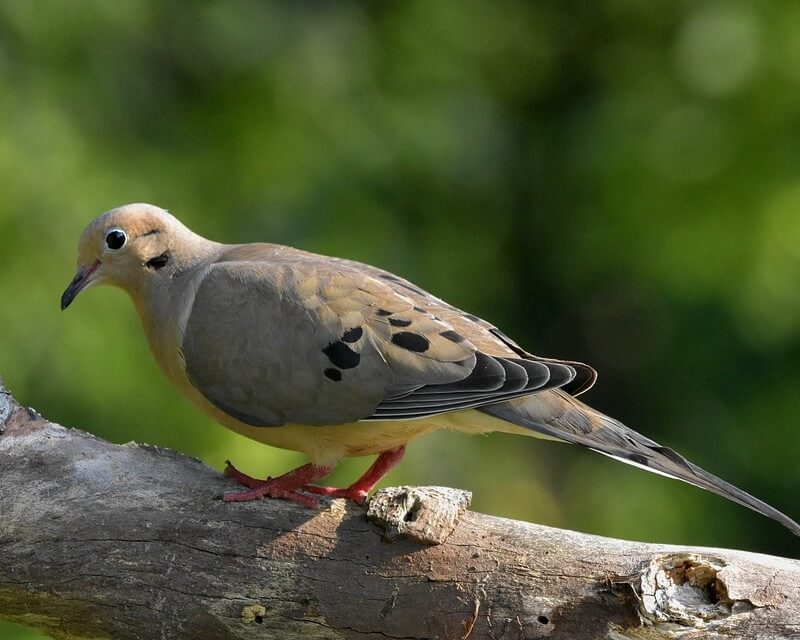
Mourning Doves are one of the most common birds in North America, and they can be found in a variety of habitats throughout Arizona.
- Zenaida macroura
- Size: 12″ (30 cm)
- AZ Checklist Frequency High: 55% in July
- AZ Checklist Frequency Low: 42% in January
Identification and Color: These slender birds have long, pointed tails and a tiny head. Brown and pale gray plumage with darker streaks on the wings and back.
Habitat and Behavior: Mourning Doves are relatively quiet birds, but they can often be heard cooing softly. Mourning Doves typically nest in trees, but they will also use man-made structures such as window ledges and gutters.
Diet: The Mourning Dove primarily eat seeds, but they will also eat insects and berries
Northern Cardinal

The Northern Cardinal is a beautiful red bird residing in Arizona year-round.
- Cardinalis cardinalis
- Size: 9″ (22.5 cm)
- AZ Checklist Frequency High: 22% in April
- AZ Checklist Frequency Low: 12% in October
Identification and Color: A very common medium-size songbird with a pointed crest and long tail. Cardinals are easily identified by their bright red plumage, making them one of the most recognizable birds in North America. The Northern Cardinal is so popular it has been named the state bird by seven states – more than any other bird.
Habitat and Behavior: Cardinals are typically found near wooded areas but can be seen in a variety of places such as suburban backyards and parks. These birds are very social creatures, and they often form pairs that mate for life.
Diet: Northern Cardinals are up for anything and will visit most bird feeders. A rather varied diet that consists of insects, fruit, berries and seeds.
Northern Mockingbird

The Northern Mockingbird is a common sight in Arizona, known for its distinctive song and plumage.
- Mimus polyglottos
- Size: 10″ (25 cm)
- AZ Checklist Frequency High: 26% in June
- AZ Checklist Frequency Low: 13% in August
Identification and Color: Northern Mockingbirds are mostly gray in color with white patches on the wings and tail. They have a long black bill and yellow eyes.
Habitat and Behavior: Northern Mockingbirds are found in open habitats such as parks, woods edges, and suburban backyards. They are active throughout the day and are known for their territorial behavior, often chasing away other birds or small animals that come too close to their nest. The Northern Mockingbird is a bit of a joker with its constant imitating of other bird calls.
Diet: Northern Mockingbirds mainly eat insects, but will also eat fruits and berries in the winter.
Red-winged Blackbird

The Red-winged Blackbird is a year-round resident of Arizona, especially near areas of water.
- Agelaius phoeniceus
- Size: 8.5″ (22 cm)
- AZ Checklist Frequency High: 15% in March
- AZ Checklist Frequency Low: 7% in August
Identification and Color: A small black bird with a striking appearance. The male has black feathers and a red patch on each wing, while the female is mostly dark brown with vertical streaks.
Habitat and Behavior: These birds are found in open areas such as marshes, meadows, and fields. Often seen near water, where they build their nests. Red-winged Blackbirds are social birds and often form large flocks.
Diet: The Red-winged Blackbird diet consists of insects, spiders, and other small invertebrates. Will also eat seeds, fruits, and berries.
Rock Pigeon

The Rock Pigeon may not be one of the most welcome birds, but a common sight in Arizona year-round.
- Columba livia
- Size: 13″ (33 cm)
- AZ Checklist Frequency High: 18% in November
- AZ Checklist Frequency Low: 9% in August
Identification and Color: The Rock Pigeon can vary in colors but commonly have iridescent throats with a blueish-gray body. They have 2 black bands on their wings and dark tail feathers. Rock Pigeons have plump bodies with small heads and short legs. Broad, pointed wings and a wide rounded tail. Their bills are straight and thin.
Habitat and Behavior: Permanent residents all over the United States and some northern areas as well, are not known to migrate. They can be found in cities and towns and rural areas like fields or farms. May flock together and spend much of their time on the ground.
Diet: The majority of the Rock Pigeon’s diet is seeds. May also eat berries or acorns and the occasional worm or insect.
Ruby-crowned Kinglet

The Ruby-crowned Kinglet is commonly seen in Arizona during the winter months.
- Regulus calendula
- Size: 4″ (11 cm)
- AZ Checklist Frequency High: 35% in December
- AZ Checklist Frequency Low: 1% in Summer
Identification and Color: The Ruby-crowned Kinglet has an olive green body with somewhat lighter underparts. They have white eye-rings and on males, the ruby red crest is only occasionally able to be seen. White and black wing bars. They are small birds with large heads and no necks. Very thin and straight bills.
Habitat and Behavior: Will breed very far north and migrates to spend the winter in the south. They like to be in tall and dense forests. Favor coniferous in the summer and deciduous in the winter because of their location. Very energetic birds that are constantly flicking their wings. They forage at many levels in the trees.
Diet: In summer the Ruby-crowned Kinglet feeds mainly on insects. During winter they will eat some berries and seeds.
Say’s Phoebe

The Say’s Phoebe is a year-round resident of Arizona.
- Sayornis saya
- Size: 7″ (18 cm)
- AZ Checklist Frequency High: 25% in December
- AZ Checklist Frequency Low: 6% in August
Identification and Color: A slender bird with a long tail. They are primarily gray-brown with a reddish underbelly. Males and females are similarly colored, and both have pointed bills. Juveniles are more brown-toned and may have reddish wing bars.
Habitat and Behavior: The Say’s Phoebe is common in the northwest and southwest. Will breed in the northwest and are permanent residents in the southwest. Will perch in a low area waiting for insects.
Diet: Consists almost entirely of insects, including bees, wasps, and winged ants.
Song Sparrow

The Song Sparrow is a small bird commonly found during warmer months in Arizona.
- Melospiza melodia
- Size: 6″ (15 cm)
- AZ Checklist Frequency High: 15% in December
- AZ Checklist Frequency Low: 8% in August
Identification and Color: The Song Sparrow is brown and gray in color with streaks on its breast and a grayish-brown back. Gets its name from its loud melody.
Habitat and Behavior: Can be found in a variety of habitats including forests, grasslands, and wetlands. The Song Sparrow is a relatively shy bird, but will happily visit bird feeders if food is available.
Diet: Song Sparrows primarily eat insects, but will also eat seeds and berries.
Verdin
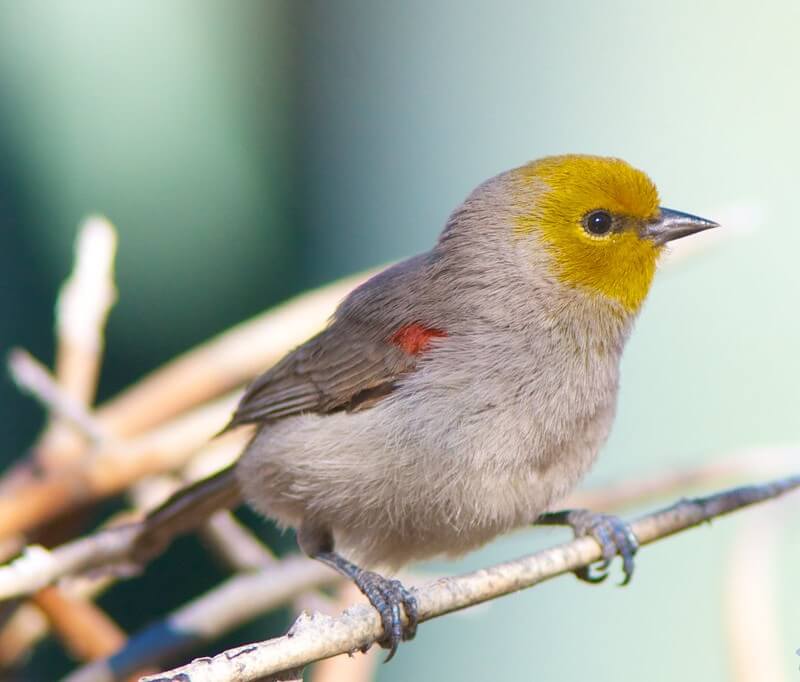
The Verdin is a year-round resident of Arizona.
- Auriparus flaviceps
- Size: 4″ (10 cm)
- AZ Checklist Frequency High: 38% in October
- AZ Checklist Frequency Low: 23% in August
Identification and Color: The Verdin has a bright yellow head. They have gray bodies with darker shades on the wings and tail. Most notably they have a bright brown patch at the bend of their wing. Tiny birds with a small head, but a long tail. Bills are tiny and pointed.
Habitat and Behavior: Found in the central south and are permanent residents there. Can be found in desert scrub and thorny brush. Will forage in shrubs and low trees.
Diet: Verdin’s have a mainly insect-focused diet. They eat tiny insects like aphids, beetles, wasp larvae, and small spiders. Will also eat small fruit, berries, and some seeds.
White-crowned Sparrow

The White-crowned Sparrow is most often seen during the winter months in Arizona.
- Zonotrichia leucophrys
- Size: 6″ (15 cm)
- AZ Checklist Frequency High: 46% in November
- AZ Checklist Frequency Low: 1% in Summer
Identification and Color: Most White-crowned Sparrows have black and white stripes around their head. The underpart is gray. They have brown, black, and white coloring on their wings and tail. They have small, pointed bills. Long tails and rounded wings.
Habitat and Behavior: Breeds in the very far north and spends the winter in the very far south. Likes brushy places that are mixed with open and grassy areas. Usually stays low to the ground. Usually forages on the ground or in low shrubs. They usually forage in flocks.
Diet: The White-crowned Sparrow mainly enjoys seeds from weeds or grasses. Will also eat some vegetable matter and insects.
White-winged Dove

The White-winged Dove can be seen year-round in Arizona.
- Zenaida asiatica
- Size: 13″ (33 cm)
- AZ Checklist Frequency High: 51% in May
- AZ Checklist Frequency Low: 6% in November
Identification and Color: The White-winged Dove is related to the Mourning Dove but owns a much larger frame. Has a long, pointed tail and a smaller rounded head. Brown and pale gray plumage with darker streaks on the wings and back. A long white streak that lines the end of its wing.
Habitat and Behavior: White-winged Doves typically nest in trees, shrubs or cactus. Can be found in a variety of habitats from suburbs to brushlands and deserts. Forages on the ground, in trees, and can even be seen sitting on top of cacti.
Diet: The White-winged Dove primarily eats seeds, but will also eat fruits and berries.
Yellow-headed Blackbird
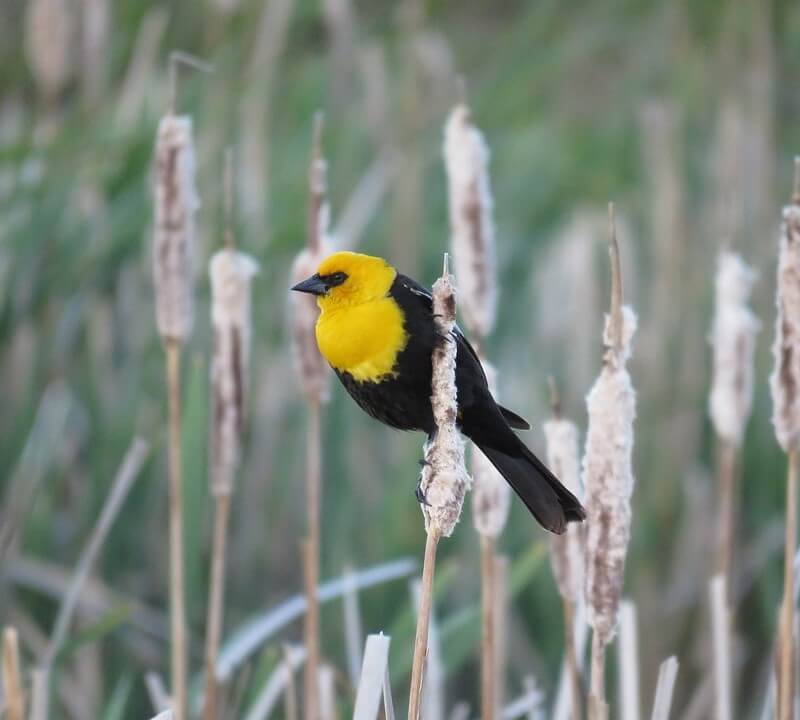
The Yellow-headed Blackbird can be seen year-round in Arizona.
- Xanthocephalus xanthocephalus
- Size: 10″ (25 cm)
- AZ Checklist Frequency High: 9% in September
- AZ Checklist Frequency Low: 2% in June
Identification and Color: Males have bright yellow heads and chests, and dark black wings with a white, and a black patch near their eyes. Females are brown and have duller yellow heads. Their bills are long and conical.
Habitat and Behavior: Yellow-headed Blackbirds can be found in the midwest to the west coast and range very far north and south. They spend their time in the north during breeding and winter in the south. Will breed in freshwater wetlands and marshes. They will form large flocks in the winter. Forages mainly on the ground.
Diet: The Yellow-headed Blackbird diet consists of seeds and insects. The majority of seeds are grass and weed seeds.
Yellow-rumped Warbler

The Yellow-rumped Warbler is most commonly seen in Arizona after the summer.
- Dendroica coronata
- Size: 6″ (15 cm)
- AZ Checklist Frequency High: 43% in October
- AZ Checklist Frequency Low: 2% in August
Identification and Color: A small warbler with a soft song, all Yellow-rumped Warblers have a patch of yellow on their sides and rump (hence the name).
Habitat and Behavior: The Yellow-rumped Warbler is typically seen in large flocks during migration in the spring and fall. Enjoys larger open wooded areas as well as brush and thickets. Most often found in trees bearing needles and cones.
Diet: Enjoys insects and berries. Difficult to attract to feeders.
Conclusion
Arizona is a great place to observe birds in their natural habitat. With its diverse habitats, ranging from desert to mountain, and its wide variety of bird species, it is no wonder that Arizona is a popular destination for birders. Whether you are a novice or an experienced birder, there is something for everyone. Be sure to check out our other articles about birds in Arizona:
Remember to keep that feeder full and have your checklist ready! Before you go, take a moment to review some of our favorite Arizona birding resources:






